Valorant’s Ranked System Explained: Everything You Need To Know
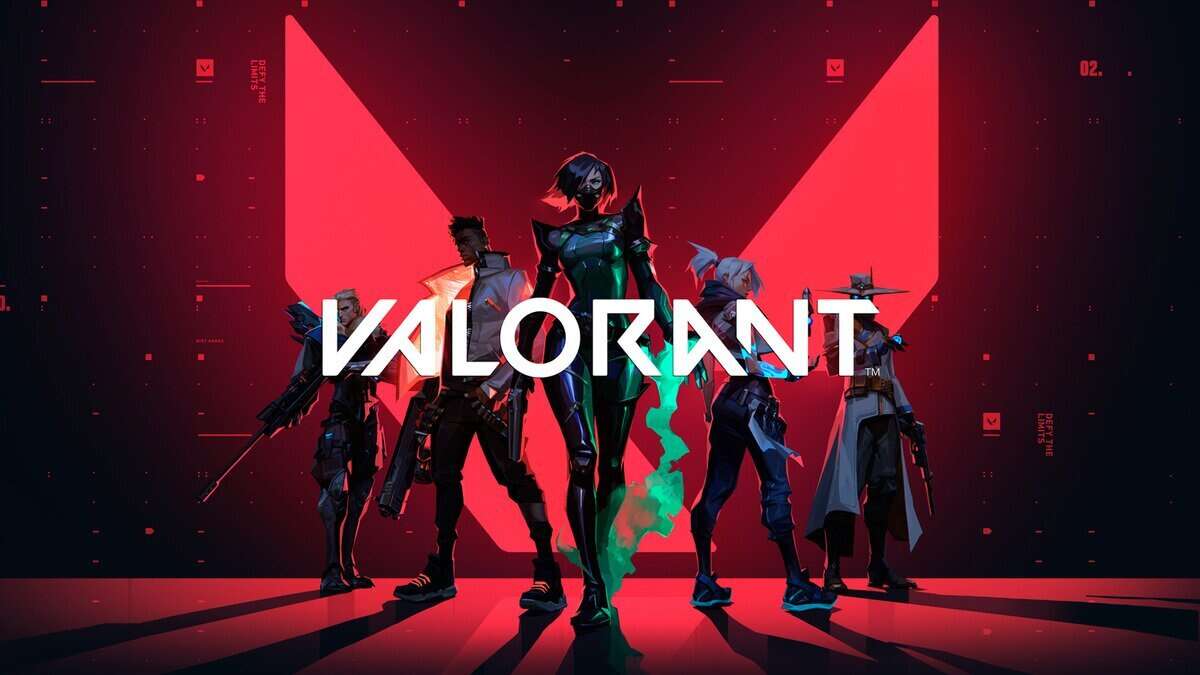
(© Riot Games)
Valorant is a popular competitive shooter with a sophisticated ranked mode. We recommend it to new players and casual fans who haven’t tried before. But before diving into the mode, you should understand how the Valorant rank system works.
Even experienced players need a reminder on the rules every so often, especially in regard to how hidden MMR works. That's where we come in! Here is our completely guide to Valorant’s ranked system.
How to unlock the competitive mode in Valorant?
Let’s start at the very beginning: How to begin playing Valorant anked.
To access the ranked mode in Valorant, you first need to unlock it. This requires reaching level 20 on your Valorant Account. You might be wondering how to level up and get the XP quickly. The best way is to spam unrated games. If you're short on time, you can try out the other game modes that don't take as long, such as Spike Rush, Swift Play, Escalation and Team Deathmatch.
You can also complete your daily and weekly missions, which you can find in the top right corner of your screen. One Profile Level equals 5000AP (Account Points), so to access ranked play, you must reach 95000 AP.
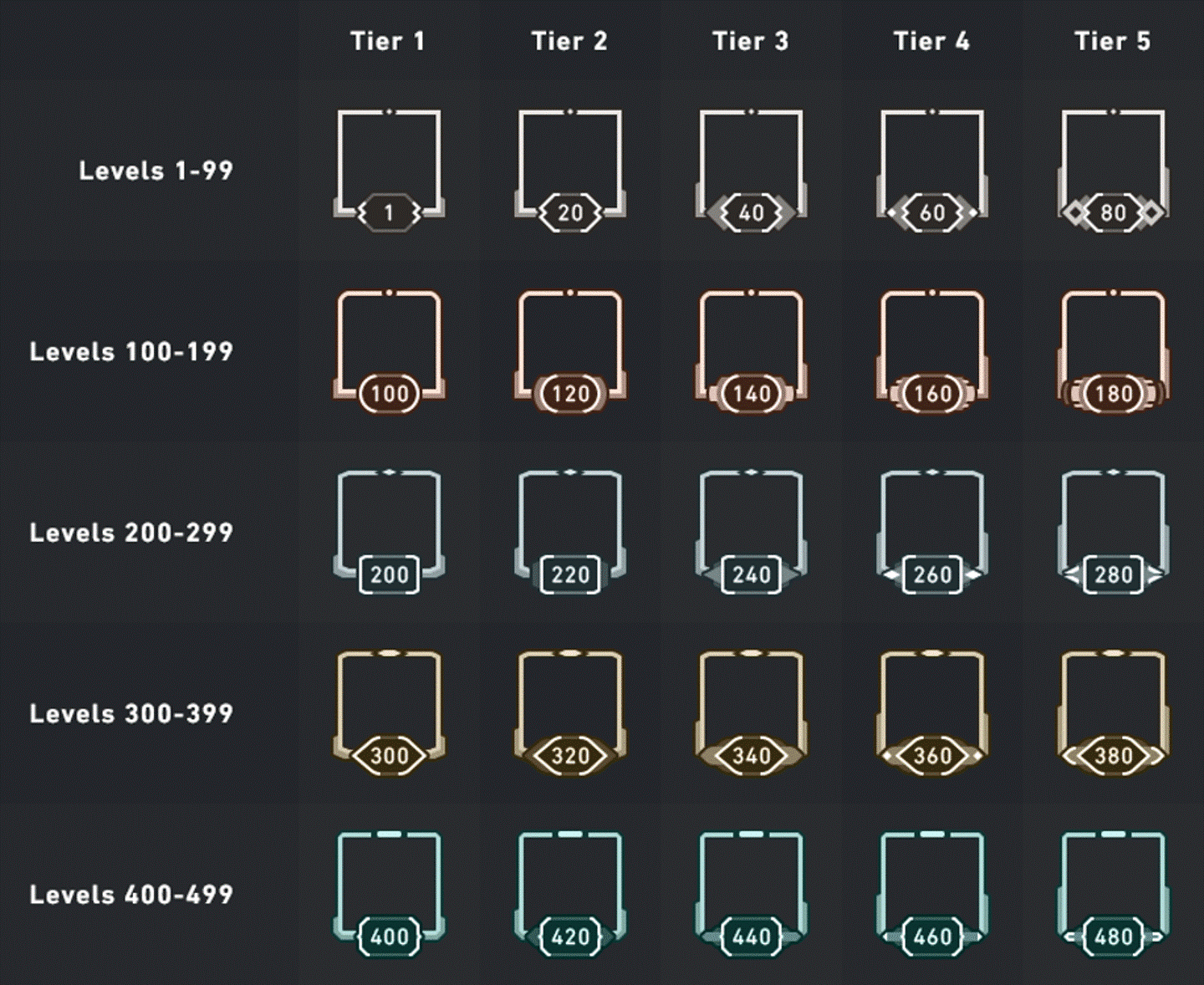
(© Riot Games)
A player's level says absolutely nothing about their skill but only how much has been played on the account.
All Ranks In Valorant
As you can see in the image below there are nine different ranks, from iron to radiant. Each rank is further divided into 3 tiers except, Radiant. You need to accumulate 100 RR (Rank Rating) to reach the next tier. For instance, you start with the lowest rank Iron 1. After reaching Iron 2 and 3, you’ll get promoted to Bronze 1 and that’s how you rank up.
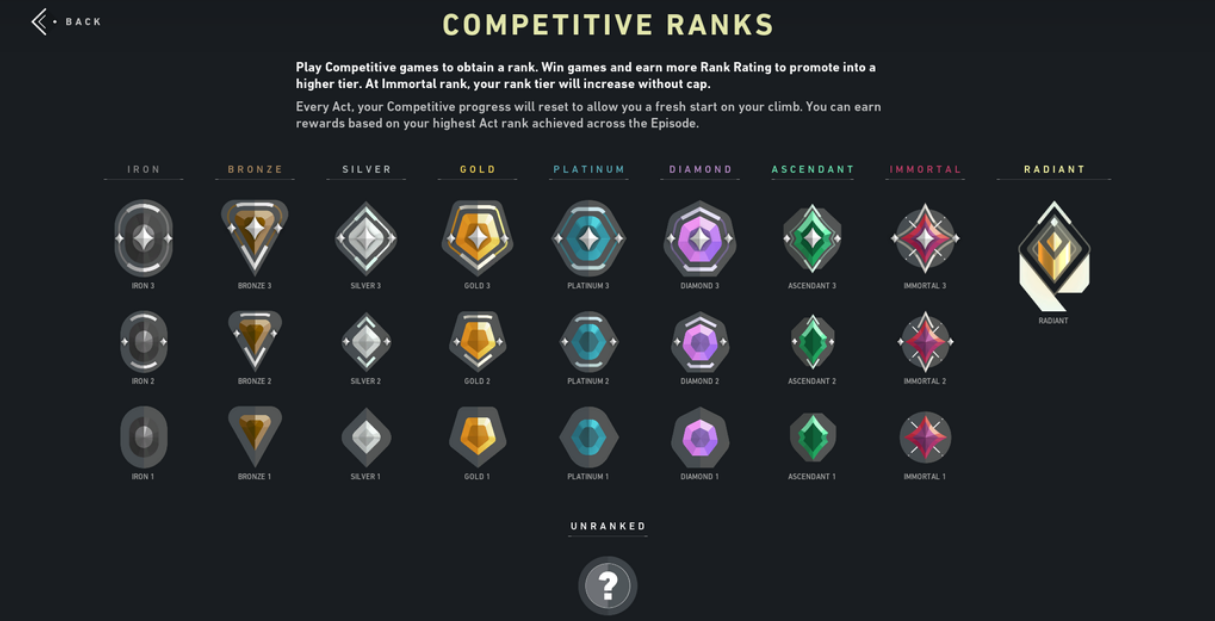
(© Riot Games)
But let’s say you're at Bronze 1 with only 3 RR. You don't need to worry about getting demoted to Iron 3 after losing the next match. As long as your RR bar isn't at zero, you can't be demoted. This means that even if you lose 20 RR in your next match, you'll still remain at Bronze 1 with 0 RR.
What is the typical Valorant rank system distribution?
First and foremost, there's no shame in being in Iron. Anyone who is new to this game, especially if they have no prior shooter experience or play very casually, can find themselves in Iron.
The rank distribution changes slightly every month, but there are some patterns.
About 10% of all Valorant players are in Iron (1-3).
In Bronze, Silver, and Gold you'll find most players, with roughly 20% in each of these ranks.
Moving up to Platinum, the percentage drops slightly to around 15%.
Diamond follows with 8-9%
T Ascendant you’ll only find 3-4% of the player base.
As you progress to Immortal, the number of players thins out to just 1%. And Radiant is the highest rank, occupied by the top 500 players, which is currently only 0.03% of the player base.
How many players can I queue with in Valorant Ranked?
In ranked you can queue as a duo or a trio, but not as a group of four. The ranks of players should not differ by more than one rank. For example, Gold players can queue with either Silver or Platinum players, but not Diamond. A five-stack is also possible and doesn’t have any rank restrictions, but Riot has specific rules for this in their FAQ:
If everyone in your 5-stack group is Ascendant 3 or below, the team will receive a 25% RR reduction if any players are ranked outside normal party restriction ranges.
If one or more members of your 5-stack group are Immortal 1 to Immortal 3, the team will receive a 25% RR reduction penalty.
If one or more of your 5-stack group are Radiant, the team will receive a 75% RR reduction. Having any players in your group that are below Radiant automatically reduces your potential RR by 90%.
Episodes, Act Rank & Peak
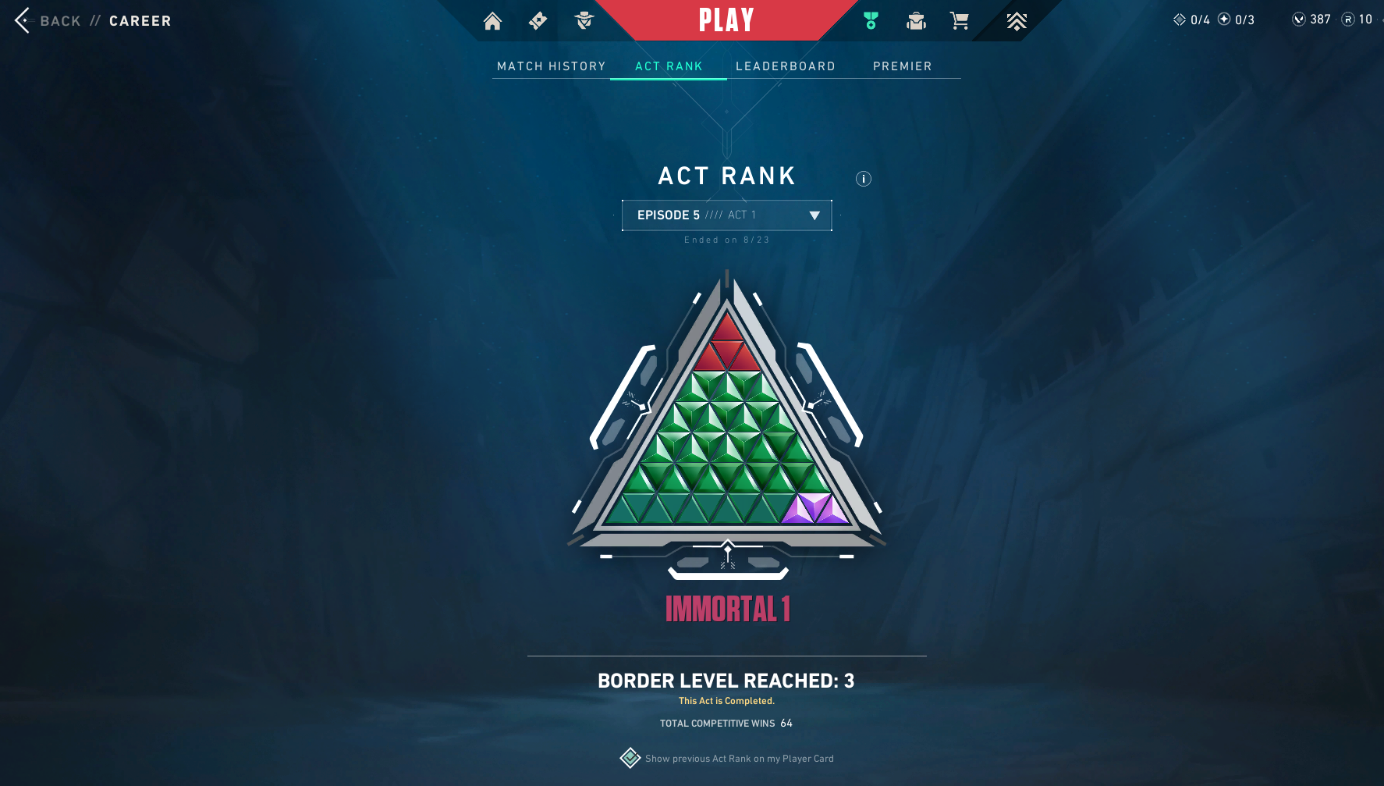
(© Riot Games)
In Valorant a season is referred to as En episode and each Episode consists of three Acts. When you go to your career, you can select the "Act Rank" tab. Here, you'll find a triangle for each individual Act you've completed with your Valorant account.
The triangle reflects the ranks you achieved during that Act and below the triangle is your so-called Peak, which shows the highest rank you reached during that Act.
When others ask you about your Peak, they typically mean the highest rank you've ever achieved. After each Episode, you receive a gun buddy of the highest rank you managed to reach.
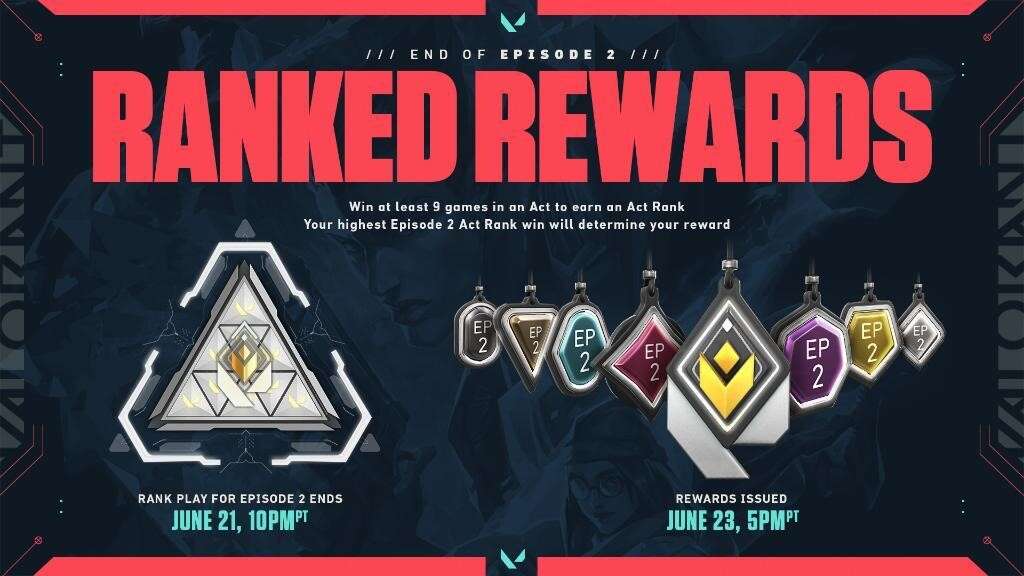
(© Riot Games)
Placement Matches
After unlocking the competitive mode, you must play five placement matches to determine your skill level. You also have to play these after each "hard reset" which happens at the beginning of every new Episode. In every new Act you have to play only one placement match.

(© Riot Games)
After the placement matches (and unless you did exceptionally well), you will be sent to the lower ranks, from where you will have to prove yourself and progress to higher ranks.
The system evaluates you based on:
Your performance in your matches.
Whether you win or lose the matches.
Your hidden Matchmaking Rating (MMR), which we will explain in more detail later.
Even if your first five placement games don't go well and you are disappointed with the rank you got, there is a "correction phase." After the first five games, you have about ten more games in which you receive an increased amount of RR when you win.
Double rank-ups are also possible during this phase. For example, you can go from Silver 2 to Gold 1.
Hidden MMR
The MMR (Matchmaking Rating) evaluates your performance based on all your ranked games in Valorant and is never reset, even after an episode ends. It's called "hidden MMR" because we cannot see it, but it significantly shapes our ranked experience.
MMR is an additional factor that determines how much RR you gain or lose after a match and also influences the ranks of your teammates and enemies.

(© Riot Games)
The matchmaking system aims to balance your MMR with your rank, meaning that if your MMR is higher than your current rank, you'll be matched against higher-ranked players and receive more RR after a win. (If your enemies have a higher rank than you, you'll receive more RR when you win.
Conversely, you'll lose more RR if your enemies are lower ranked than you.) However, your in-game performance is also a crucial factor in determining the amount of RR you win or lose. MMR helps the Valorant rank system create more even games, no matter the rank of the players.
Performance
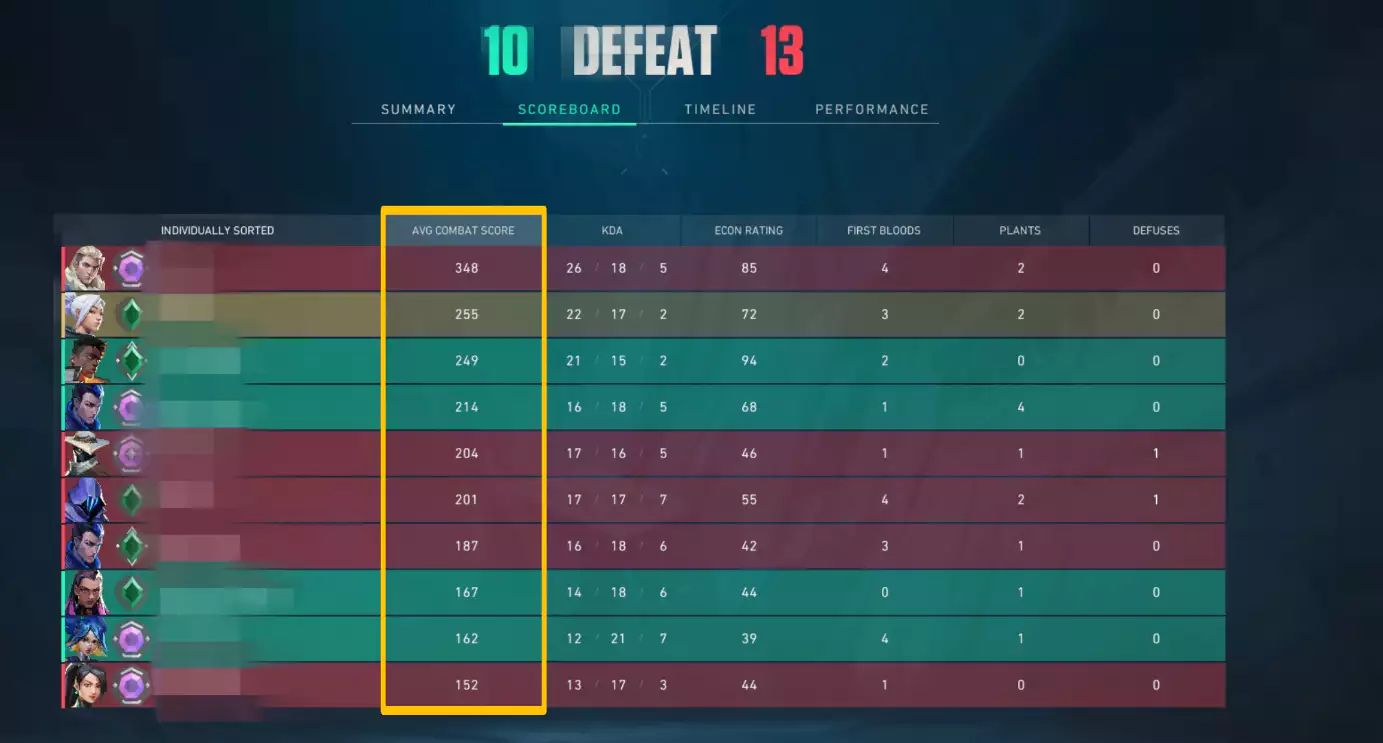
(© Riot Games)
After every competitive match, you are presented with a table that breaks down the performance of both teams. This table sorted by the average combat score, which measures the performance of the players.
This score takes into account various factors, including the obvious ones like kills, deaths and assists, as well as the damage dealt and "First Bloods" bonus (First Blood means being the first to eliminate an enemy in a round).
And that brings us to the end of our guide on the Valorant ranked system, we hope you found it helpful.







